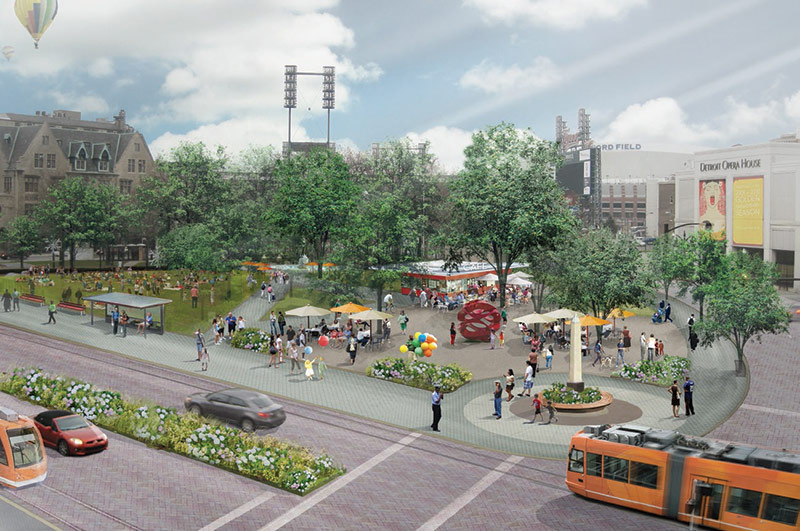
In March, Detroit’s Rock Ventures presented a vision for a revitalized urban core built around public spaces, while the city’s elected officials conceded to the state’s appointment of an emergency financial manager.
Rock Ventures chairman Dan Gilbert proposed the plan alongside the Downtown Detroit Partnership and the Detroit Economic Growth Corporation. Gilbert carries considerable clout in the local real estate market, where his companies own more than 3 million square feet of commercial space. Rock Ventures has spent nearly $1 billion buying downtown property since 2010.
|
Current view of Campus Martius / Cadillac Square (left) and a rendering of the proposed reactivated site (right)..
|
||
The plan envisions a place that is “dense, lively, and attractive for people from the entire region and beyond,” built around three major public spaces and the recently approved M-1 streetcar. It touts “the power of 10,” the idea that 10 great locations—each with 10 destinations, each with 10 things to do—comprise a great downtown and can spur further development through economic multiplier effects.
Urban consulting firms Project for Public Spaces, Shook Kelly, Gibbs Planning Group, and Terremark Partners contributed to the seven-month research process that included workshops with community development groups. The plan focuses in on the area of downtown from the Detroit River to Grand Circus Park, calling out six districts that could catalyze development and sustain downtown culture: Campus Martius/Cadillac Square, Capitol Park, Woodward Avenue, Lower Woodward, Library District, and Grand Circus Park.
Gilbert revealed some plans involving his recent acquisitions, such as the 1001 Woodward building. He held up as an example plans to open the ground floor to foot traffic and pedestrian interaction. The area around Camp Martius, for example, is listed in the report as a prime site to create such “gathering places” that could link together emerging retail development.
The long-term vision expands on that idea, calling for reduced roadways, with more street plantings and wayfinding leading to a pedestrian-friendly Market Square. The group Opportunity Detroit also made an open call to architects and designers to present ideas for the former Hudson’s department store site.
It is an understatement to say Detroit has changed dramatically since its 1951 Master Plan. But efforts by Gilbert and others have begun to move the needle on downtown redevelopment, and their intention is to have an immediate impact. Improvements to some downtown streets and parks will begin this summer, along with construction on the M-1 rail line.